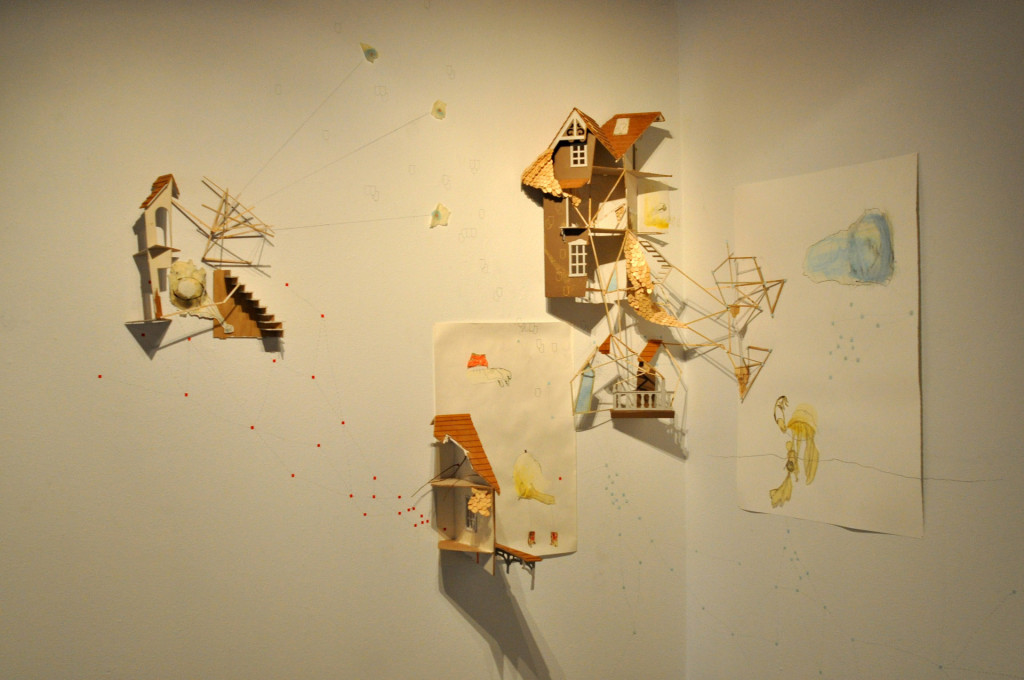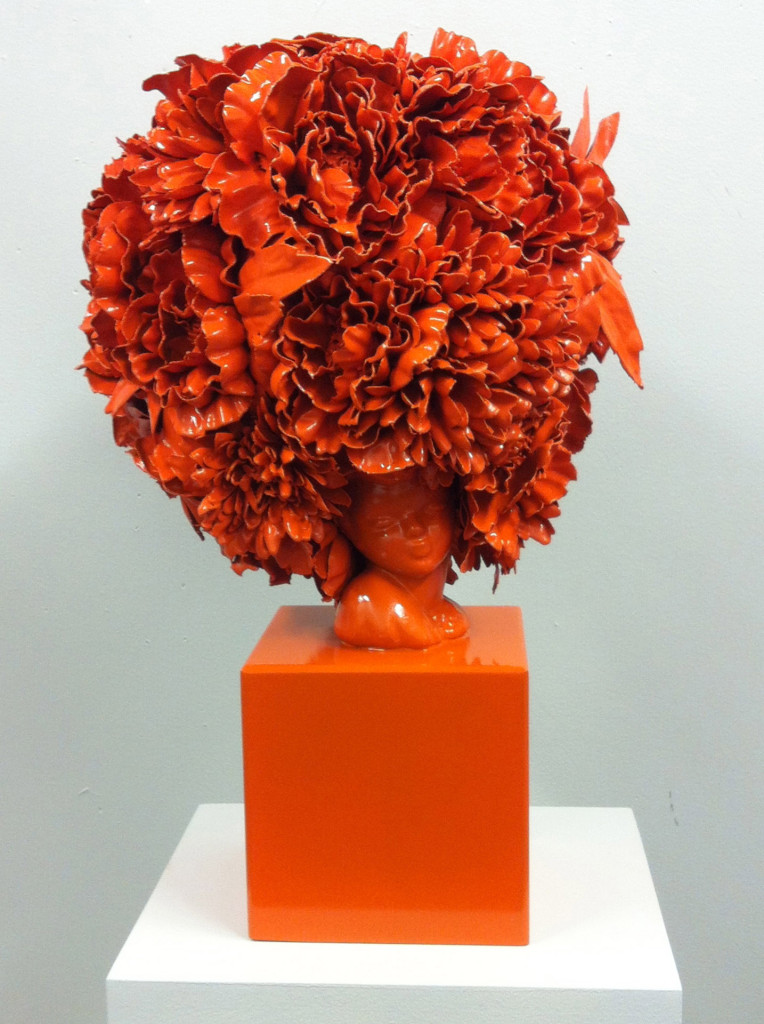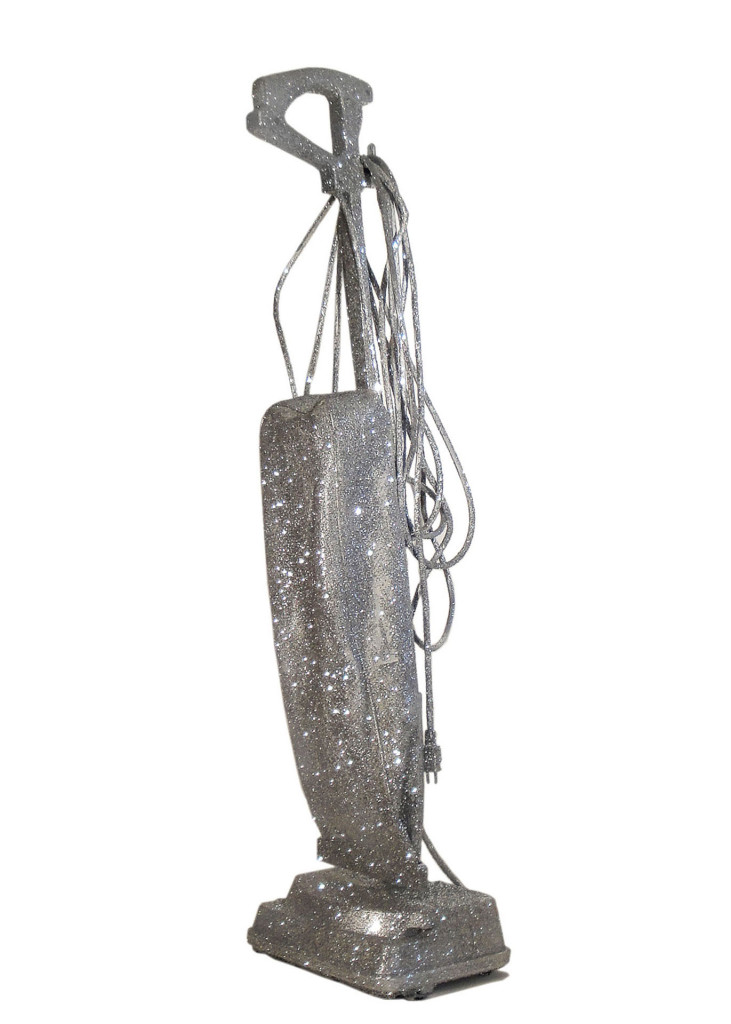
Imelda Marcos, the notorious Filipino politician, once said, “I have never been a material girl. My father always told me never to love anything that cannot love you back.” She was also the owner of an infamous shoe collection reputed to be made up of as many as 3,000-plus pairs. The exhibition Material Witness at the Dalton Gallery of Agnes Scott College, on view through November 16, displays a dizzying lineup of objets d’art, painting, drawing, photography, sculpture, and obtainium to love, covet, be repelled by and attracted to. Multiple concepts, materials of many types, and techniques that employ most art processes are on rampant display. This profusion is both the show’s immense strength and its occasional distraction.
The daunting task of bringing so many creative voices together through the jurying process went to local experts Lynn Marshall-Linnemeier, Marcia Wood, and Lisa Alembik. In submitting work to this juried exhibition, sponsored by the Women’s Caucus for Art of Georgia, artists focused on the transformation of materials and a broad definition of witness. This show has something for everyone. What there isn’t is work that is about being a material witness.
Anna Maddocks’s intriguing installation The Beginning of Some Story I’ll Never Finish features a deconstructed balsa wood Victorian dollhouse. Transformed from an ideal family home in miniature to a destabilized, Wizard of Oz-after-the-tornado set, it becomes an unsettling, primitive environment. Drawings introduce landscape and “characters” into the picture plane but lack the successful integration evident in the rest of the work; they remain pieces of paper gratuitously tacked up. Had they been drawn directly on the wall, the work would have had more cohesion.

In Cherished Tchotchke Knows Her Place (orange) Stacy Rexrode has unified common materials into a sculpture reminiscent of Roman portrait busts. The saturated orange enamel paint covering it belies its demure subject matter and introduces shock. Rexrode’s intent is to improve the status of nontraditional materials, combining them with typical art materials to alter how they are often utilized. This is especially evident when one peeks under the huge ’fro to find a sweet Lady Head vase that might have graced grandma’s home.
Utensils by Carrie Spencer is a work one can walk past, never realizing the actual materials used. Closer inspection (and a dose of personal experience?) reveals that sex toys have been morphed with common domestic objects into monochromatic sculptures that figuratively combine the oft dysfunctional aspects of women’s roles. Hung from 1950s gelatin molds, the dangling appendages take on a sinister, repellent quality. Sustenance and sex … every woman’s domestic dream?

We’ve come a long way, baby, and much time has passed since the Medieval period, but in Fountain Dorothy Cheng suggests that women are still subject to much of the same scrutiny and pressures as in ages past. Using human hair and wool, she has felted a garment reminiscent of a hair shirt. Such garb was worn for mortification and religious penance, and the wearer was in a perpetual state of extreme discomfort as a constant, physical reminder of sin. A beaded hole leads the eye into where a heart should be, but is not. What we expect is often not what we get.
In Bloom we get a shockingly lovely pair of earrings constructed of hypodermic needles. Their pink plastic feminizes, perhaps diverting attention from the dangerous element of the sharp points. Artist Alexandra Cheney creates works meant to repel rather than attract. Cheney believes that in order for there to be any hope for the future of humanity, people must give up their unrestricted freedom to breed, and jewelry must reverse its influence in sexual selection and repel likely suitors rather than assist in attracting a mate.
Pride in the home has traditionally exemplified femininity and domesticity. Amanda Dumas-Hernandez elevates the vacuum to a godlike status in Curse/Blessing #11: Suck Up. Common craft glitter transforms an upright into the divine. Utilitarian objects covered in sparkly become glamorous (feminized) while also rendering the machine useless (emasculated). Reminiscent of Nicola Bolla’s sumptuous, disturbing Swarovski crystal works, this assemblage and her glitter mirror installation Self-Reflection—also in the show—are wonderfully childlike, lowbrow interpretations.

In stark contrast, Melissa Precise in her large performance installation Forever and Always uses the aggressive act of burning a natural material—wood—to address the human challenge in our destruction of the earth. Materials become the message in her extraordinary three-dimensional works.
Evidence or proof of witness as a concept can be seen in many two-dimensional works. Cecelia Kane documents her aging process through daily self-portraiture, thereby becoming a resigned, mortal witness to her own materiality and nonmateriality. How Am I Feeling Today? is an extraordinary testament to the collective power of personal documenting and the impact of displaying it en masse.
Cat Manolis mixes material and message seamlessly in Unstable Environment #3: The Future is Not Like Before. Dictator Mao Zedong has the role of lead performer but is upstaged by ludicrous characters: the tiger, a symbol of power; and headless, celebrity lounge lizard politicians, purveyors of atrocities. The use of lush, feminine pink flooring is in sharp contrast to the masculine, concrete block walls. The whole scene has a garish tinge evocative of political absurdity, apropos to modern times.
Kristin Skees’s The Gannons nods to staid eighteenth-century British portraiture, but the placement of a man and woman in the tense tableau creates a very contemporary shot of domestic isolation. This mood is further enhanced by the heightened superficiality Skees uses: the wall-mounted flat screen “playing” a romantic fireplace fire; the knitted cozies cocooning and obscuring the couple, and an obedient white cat placed strategically in the foreground. All these elements contribute to an intriguing work that nudges the viewer into the scene.

Jennifer Moore’s photograph Transcendental Parts of the Whole places the viewer into the titillating role of unfulfilled voyeur. The varying states of disconnect deny the viewer any interaction. Solid technical use of soft-to-high focus photography creates moodiness in this complex scene of human disengagement. The viewer is left to ponder what is going on in this photograph noir.
Jessica Burke’s meticulous graphite drawings Stephanie as Betty Rizzo of Rydell High and Paula as Spock of the USS Enterprise address body image, beauty, and gender in a humorous, accessible manner. The artist explores how media influences identity construction by portraying a Spock in pregnant, female form, and Rizzo as a less-than-ideal body type. The scale used renders them almost life-size, placing the characters directly amid the crowd. Each of these women could be your neighbor in a new reality show.
Other works in the show display varying degrees of success in addressing the theme. Many paintings in particular seemed to have a remote disconnect from the concept, but there is no trial to be held here, there is no material witness. What there is, is a fabulous assortment of works worth seeing.
You be the judge.




